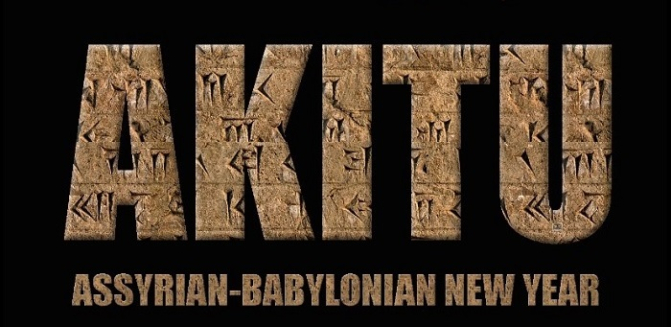AKITU: The Mesopotamian New Year
A series of brief introductions to ancient Mesopotamian gods, beliefs and feasts.
You can watch the associated Suroyo TV broadcast (in Turkish) with journalist Yawsef Beth Turo and Nurgül Çelebi here.
By Nurgül Çelebi
Akitu, also known as Akitum, is the Mesopotamian New Year festival. Such festivals are among the oldest and the most universally observed today. The earliest known record of a New Year festival dates to about 2000 BCE in Mesopotamia, where in Babylonia the new year began with the new moon after the spring equinox and in Assyria with the new moon nearest the autumn equinox.
Considered the harbinger of spring, Akitu was a spring festival held in ancient Mesopotamia to celebrate the planting of barley in the first month of Nisanu. The Babylonian and Assyrian Akitu festival played a very important role in the development of religion, myth, and ritual theories. The Akitu festival symbolizes the revival of nature, fertility, new life, and resurrection. Although the purpose of the festival is a matter of debate among both historians of religion and Assyriologists, it is certain that it played a crucial role in the advancement of Mesopotamian and Western civilizations, because it was an important festival that provided the flow of information and cultural transfer on issues such as the effect of the equinoxes, the use and development of calendars, and the efficiency of agriculture. The Babylonian festival traditionally started on April 4, the first month of the year, as a celebration of the sowing of barley. All the people in the city would celebrate, including the awilu (upper class), muskena (middle class), wardu (lower class), the High Priest, and the King. Thus, elements such as a special sharing among the people, a sense of unity, a common purpose, enthusiasm, and joy made the society strong.
This festival, where various practices and rituals were performed for 12 days, was accepted in the Neo-Assyrian Empire after the destruction of Babylon. Akitu, where special rituals are performed every day, is almost a transition period to another season. The most striking celebration of the Akitu festival were the ceremonies symbolizing the resurrection. Accordingly, the image of the worshiped holy god was taken from its place in the temple and taken, in a magnificent parade, to the predetermined Akitu temple (Bit Akiti), which was usually located near the river. In particular, the water of the Tigris and Euphrates rivers was considered sacred. The water taken from these rivers was collected in a well prepared in Bit Akiti and used for the purification ritual associated with the festival. During the festival, this ritual of purification with water was practiced. This practice can be considered as one of the earliest examples of a kind of baptism. This ritual symbolized the descent of the god to the underworld and his ascent back to earth in spring. In 683 BC, King Sennacherib built an “Akitu house” outside the Assyrian walls. Historical sources tell us that another Akitu house was also built outside of the city of Nineveh.

Akitu in other civilizations
It is known that it was celebrated not only by the civilizations of Babylon and Assyria, but also by many other Mesopotamian societies and peoples such as the Akkadians and Arameans. Moreover, Akitu was also celebrated in some western civilizations. The thousand-years-old Akitu festival continued throughout the Seleucid Empire. Until the beginning of the third century, it was celebrated in honor of the god Elagabal in the city of Emesa – modern-day Homs in Syria. According to some sources, the Roman emperor Elagabalus (218-222) even introduced the festival in Italy.

Akitu, which continues to be celebrated today as a festival by the Syriac people in e.g., Nohadra (Duhok) in Iraq but also all over the world, symbolizes the new year, the arrival of spring, fertility, and resurrection, and is one of the rare traditions that have remained for thousands of years. Although societies have changed, religions, traditions and even the calendars have changed, it is very important to maintain this tradition. Akitu, is an important legacy as it symbolizes the continuation and resurrection of a culture of thousands of years. It is very interesting that this festival, which has been celebrated for more than six thousand years according to the Assyrian calendar, has been adopted by almost all societies and is accepted as a transition to a new year.
May the new year bring peace. Happy Akitu. Happy New Year!

Nurgül Çelebi was born in 1985 in Istanbul. She holds a master’s degree from the Syriac Language and Culture Department at Mardin Artuklu University with her thesis on Sun and Moon Symbolism in Syriac literature. She continues her Ph.D. program in the history of religions at Ankara University with her thesis on “Sin-Shamash Duality and Its Reflection on Religions”. She is currently continuing her second Ph.D. in the Assyrian History doctorate program at ELTE University in Budapest.
Nurgül Çelebi works on Mesopotamian beliefs and mythologies and published papers on these subjects. In addition to academic studies, she has published three novels in Turkish: “Yarına Dokunmak“, “Aşka Dokunmak”, and “Tanrı Dağı”. Her stories have appeared in five anthologies: “Karanlıktaki Kadınlar”, “Hayalet Müzik”, “Eskilerin Şöleni”, “Dark Antoloji Birinci Kitap”, and “Dark Antoloji İkinci Kitap”.




















